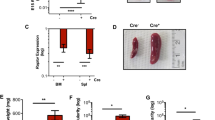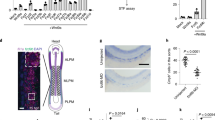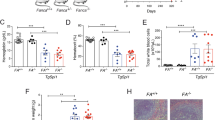Abstract
The c-kit-encoded transmembrane tyrosine kinase receptor for stem cell factor (Kit/SCF-R) is required for normal haematopoiesis, melanogenesis and gametogenesis1,2,3. However, the roles of individual Kit/SCF-R-induced signalling pathways in the control of developmental processes in the intact animal are completely unknown. To examine the function of SCF-induced phosphatidylinositol (PI) 3′-kinase activation in vivo, we employed the Cre-loxP system4 to mutate the codon for Tyr719, the PI 3′-kinase binding site in Kit/SCF-R, to Phe in the genome of mice by homologous recombination. Homozygous (Y719F/Y719F) mutant mice are viable. The mutation completely disrupted PI 3′-kinase binding to Kit/SCF-R and reduced SCF-induced PI 3′-kinase-dependent activation of Akt by 90%. The mutation induced a gender- and tissue-specific defect. Although there are no haematopoietic or pigmentation defects in homozygous mutant mice, males are sterile due to a block in spermatogenesis, with initially decreased proliferation and subsequent extensive apoptosis occurring at the spermatogonial stem-cell level. In contrast, female homozygotes are fully fertile. This is the first report so far demonstrating the role of an individual signalling pathway downstream of Kit/SCF-R in the intact animal. It provides the first in vivo model for male sterility caused by a discrete signalling pathway defect affecting early germ cells.
This is a preview of subscription content, access via your institution
Access options
Subscribe to this journal
Receive 12 print issues and online access
$209.00 per year
only $17.42 per issue
Buy this article
- Purchase on Springer Link
- Instant access to full article PDF
Prices may be subject to local taxes which are calculated during checkout




Similar content being viewed by others
References
Besmer, P. et al. The kit-ligand (steel factor) and its receptor c-kit/W: pleiotropic roles in gametogenesis and melanogenesis. Development Suppl. 125–137 (1993).
Galli, S.J., Zsebo, K.M. & Geissler, E.N. The kit ligand, stem cell factor. Adv. Immunol. 55, 1–96 (1994).
Lyman, S.D. & Jacobsen, S.E. c-kit ligand and Flt3 ligand: stem/progenitor cell factors with overlapping yet distinct activities. Blood 91, 1101–1134 (1998).
Metzger, D. & Feil, R. Engineering the mouse genome by site-specific recombination. Curr. Opin. Biotechnol. 10, 470–476 (1999).
Blume-Jensen, P., Rönnstrand, L., Gout, I., Waterfield, M.D. & Heldin, C.H. Modulation of Kit/stem cell factor receptor-induced signaling by protein kinase C. J. Biol. Chem. 269, 21793–21802 (1994).
Blume-Jensen, P., Janknecht, R. & Hunter, T. The kit receptor promotes cell survival via activation of PI 3-kinase and subsequent Akt-mediated phosphorylation of Bad on Ser136. Curr. Biol. 8, 779–782 (1998).
Lev, S., Givol, D. & Yarden, Y. Interkinase domain of kit contains the binding site for phosphatidylinositol 3′ kinase. Proc. Natl Acad. Sci. USA 89, 678–682 (1992).
Serve, H., Hsu, Y.C. & Besmer, P. Tyrosine residue 719 of the c-kit receptor is essential for binding of the P85 subunit of phosphatidylinositol (PI) 3-kinase and for c-kit-associated PI 3-kinase activity in COS-1 cells. J. Biol. Chem. 269, 6026–6030 (1994).
O'Gorman, S., Dagenais, N.A., Qian, M. & Marchuk, Y. Protamine-Cre recombinase transgenes efficiently recombine target sequences in the male germ line of mice, but not in embryonic stem cells. Proc. Natl Acad. Sci. USA 94, 14602–14607 (1997).
Alessi, D.R. & Cohen, P. Mechanism of activation and function of protein kinase B. Curr. Opin. Genet. Dev. 8, 55–62 (1998).
Downward, J. Ras signalling and apoptosis. Curr. Opin. Genet. Dev. 8, 49–54 (1998).
Lennartsson, J. et al. Phosphorylation of shc by src family kinases is necessary for stem cell factor receptor/c-kit mediated activation of the Ras/MAP kinase pathway and c-fos induction. Oncogene 18, 5546–5553 (1999).
Manova, K., Nocka, K., Besmer, P. & Bachvarova, R.F. Gonadal expression of c-kit encoded at the W locus of the mouse. Development 110, 1057–1069 (1990).
Schrans-Stassen, B.H.G.J., van de Kant, H.J.G., de Rooij, D.G. & van Pelt, A.M.M. Differential expression of c-kit in mouse undifferentiated and differentiating type A spermatogonia. Endocrinology 140, 5894–5900 (1999).
Ogawa, T., Dobrinski, I., Avarbock, M.R. & Brinster, R.L. Transplantation of male germ line stem cells restores fertility in infertile mice. Nature Med. 6, 29–34 (2000).
Yoshinaga, K. et al. Role of c-kit in mouse spermatogenesis: identification of spermatogonia as a specific site of c-kit expression and function. Development 113, 689–699 (1991).
Manova, K. et al. The expression pattern of the c-kit ligand in gonads of mice supports a role for the c-kit receptor in oocyte growth and in proliferation of spermatogonia. Dev. Biol. 157, 85–99 (1993).
Cooke, J.E., Godin, I., French-Constant, C., Heasman, J. & Wylie, C.C. Culture and manipulation of primordial germ cells. Methods Enzymol. 225, 37–58 (1993).
Bellve, A.R. Purification, culture, and fractionation of spermatogenic cells. Meth. Enzymol. 225, 84–113 (1993).
Heuchel, R. et al. Platelet-derived growth factor beta receptor regulates interstitial fluid homeostasis through phosphatidylinositol-3′ kinase signaling. Proc. Natl Acad. Sci. USA 96, 11410–11415 (1999).
Maina, F. et al. Uncoupling of Grb2 from the Met receptor in vivo reveals complex roles in muscle development. Cell 87, 531–542 (1996).
Godin, I. et al. Effects of the steel gene product on mouse primordial germ cells in culture. Nature 352, 807–809 (1991).
Dolci, S. et al. Requirement for mast cell growth factor for primordial germ cell survival in culture. Nature 352, 809–811 (1991).
Matsui, Y. et al. Effect of Steel factor and leukaemia inhibitory factor on murine primordial germ cells in culture. Nature 353, 750–752 (1991).
Fruman, D.A., Meyers, R.E. & Cantley, L.C. Phosphoinositide kinases. Annu. Rev. Biochem. 67, 481–507 (1998).
Leevers, S.J., Vanhaesebroeck, B. & Waterfield, M.D. Signalling through phosphoinositide 3-kinases: the lipids take centre stage. Curr. Opin. Cell Biol. 11, 219–25 (1999).
Rommel, C. et al. Differentiation stage-specific inhibition of the Raf-MEK-ERK Pathway by Akt. Science 286, 1738–1741 (1999).
Kogan, S.C., Doherty, M. & Gitschier, J. An improved method for prenatal diagnosis of genetic diseases by analysis of amplified DNA sequences. Application to hemophilia A. N. Engl. J. Med. 317, 985–990 (1987).
Blume-Jensen, P., Siegbahn, A., Stabel, S., Heldin, C.H. & Rönnstrand, L. Increased Kit/SCF receptor induced mitogenicity but abolished cell motility after inhibition of protein kinase C. EMBO J. 12, 4199–4209 (1993).
Blume-Jensen, P. et al. Activation of the human c-kit product by ligand-induced dimerization mediates circular actin reorganization and chemotaxis. EMBO J. 10, 4121–4128 (1991).
Acknowledgements
We thank E.A. Barcarse for help with ES cells; S. Kwoh and B.A. Dominguez for assistance with breeding and blastocyst injections, respectively; E. Saez, Y. Dayn, W. Lin, C. Bentley, S. Crone, J. Morris and J. DeFratis and the staff at the Transgenic Facility at Salk; R. Rottapel for advice on mast cell isolation; D. Lee for advice on total blood cell counts, and C. Barlow for advice on testicular development and histology; T. Chan and I. Gout for antibodies; and N. Carter and M. Latterich for discussion. This work was supported by NIH grants from the NCI to T.H., from HD to K.-F.L., and from GM to S.O'G. P.B.-J. is a Special Fellow of the Leukemia Society of America, K.-F.L. a Pew Scholar, and T.H. a Frank and Else Schilling American Cancer Society Professor.
Author information
Authors and Affiliations
Corresponding authors
Rights and permissions
About this article
Cite this article
Blume-Jensen, P., Jiang, G., Hyman, R. et al. Kit/stem cell factor receptor-induced activation of phosphatidylinositol 3′-kinase is essential for male fertility. Nat Genet 24, 157–162 (2000). https://doi.org/10.1038/72814
Received:
Accepted:
Issue Date:
DOI: https://doi.org/10.1038/72814
This article is cited by
-
The involvement of bioactive factors in the self-renewal and stemness maintenance of spermatogonial stem cells
Molecular and Cellular Biochemistry (2021)
-
Testicular Stem Cell Dysfunction Due to Environmental Insults Could Be Responsible for Deteriorating Reproductive Health of Men
Reproductive Sciences (2021)
-
Altered Biology of Testicular VSELs and SSCs by Neonatal Endocrine Disruption Results in Defective Spermatogenesis, Reduced Fertility and Tumor Initiation in Adult Mice
Stem Cell Reviews and Reports (2020)
-
Activated c-Kit receptor in the heart promotes cardiac repair and regeneration after injury
Cell Death & Disease (2016)
-
Inositol(s) in thyroid function, growth and autoimmunity
Reviews in Endocrine and Metabolic Disorders (2016)



